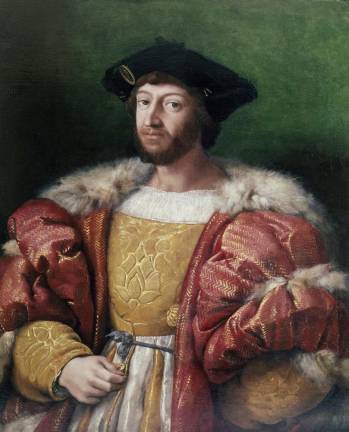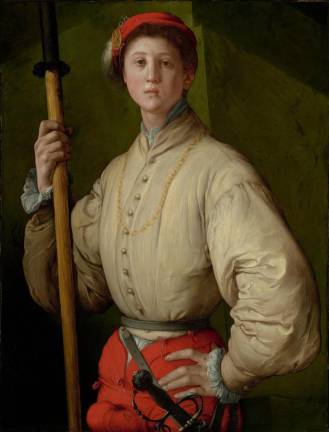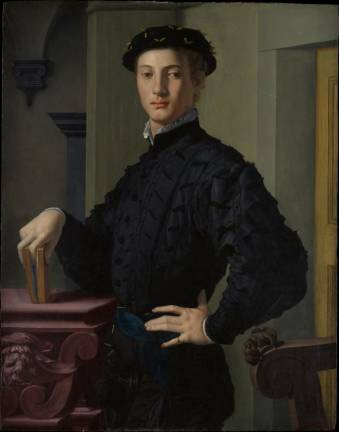“The Medici: Portraits and Politics, 1512-1570” (until Oct. 11) could be the first post-pandemic blockbuster show, and an appropriate one. Many of the works were produced in Florence during the Plague years. The public bonfires of Fra Savonarola were still smoldering. France invaded Florence. Spain invaded Florence. Through it all, the Medici toggled in and out of power, with the occasional assassination, public betrayals, public hangings, sieges, civil wars, banishments and triumphant returns.
During this turbulent time, one man eventually seized power and kept it. Cosimo I de’ Medici toppled the Florentine Republic, a free city that elected its leaders. He rewrote its constitution and made it a duchy under his control. He used art as propaganda, to convey messages about him, the Medici, and Florence.
The scale of the Met Museum’s show is as huge as the Medici family: 90 works from 18 countries, by Raphael, Titian, Bronzino, Pontormo, Salviati, Cellini, and others; paintings, sculptures, bronzes, carved gemstones, cast medals, armor, etchings, manuscripts, books... and one elaborate court gown once worn by Cosimo’s wife, the formidable Eleonora of Toledo.
You’re greeted by a marble bust and a Cellini bronze bust of Cosimo. His armor suggests Caesar Augustus, but his attitude is pure Mafia Don. (He became Duke of Florence in 1537, at 17, following the assassination of his predecessor, Alessandro de’ Medici.)
Transition of Florence
The first rooms show the transition of Florence from independent republic to a duchy. The republican portraits are austere, the men in sober black, holding a letter or a book. They look at the viewer warily (Like Del Sarto’s “Portrait of a Man”) or with a challenging air. Pontormo’s portrait subjects, hands on hip, stare at the viewer with subtle defiance. These Pontormo portraits – all of them, in fact – are his most restrained work. There’s no elongated, floaty Mannerism; these are real people anchored by their time, but they all have a haunting quality, perhaps pondering what the future holds under the Medici.
The other side of the room shows the price of resistance at the Siege of Florence. A cabinet displays the weapons: a battle axe big enough for a motto etched on the blade (and owned by a Cardinal!), swords, and a halberd – a lance with a huge hooked blade. The gold fringe near the top is not decoration. It prevents blood from dripping down the handle making it slippery to hold.
Nearby, Pontormo’s “Portrait of a Halberdier” shows a young man holding the weapon. His billowy sleeves are crisply defined, every fold in place. He stares at the viewer with cool insouciance, and holds the halberd with a firm grip, his other hand on his sword. He is about 16 years old.
The republic forces lost, starved into submission after a three year siege. Two years later Cosimo rewrote the city’s constitution and ended the republic. He confiscated the property of his opponents, like the banker Bindo Altoviti. Others, like Michelangelo, fled the city. (Interestingly enough, as strong as the de’ Medici brand was, Michelangelo’s was stronger. Cosimo constantly worried that Il Divino rejected the Medici – doubly so because he so loved Il Magnifico. Cosimo actually contrived to have Michelangelo’s body stolen from Rome and brought back to Florence for burial.)
A Family Affair
Much of the show is a Medici family album painted by Bronzino and other Renaissance icons. Bronzino, the court painter, specialized in impassive, even haughty portraits loaded with detail of jewelry and fabric, textures and sheen. (His “Portrait of a Young Man with a Book,” although loaded with playful details like faces hidden in fabric, is forbidding and cold.) However, there’s one portrait, the only one by Raphael, with a different type of Medici. His Lorenzo de’ Medici, Duke of Urbino wears a very lively French outfit, a fancy hat, and a satisfied expression. (Perhaps because he was a Francophile and was about to marry into French royalty.) You can practically feel the texture of the patterned velvet, the sheen of the silk, the delicacy of the fur trim. This work is from a private collection, so make sure you see this one.
At every opportunity, Cosimo used art to enhance his stature and by extension, the status of Florence under his rule. He was helped by his wife Eleanora of Toledo: the original Power Couple. She commissioned many portraits of her children (she had 11), richly attired, and distributed copies to royalty throughout Europe, hoping for some matchmaking.
Cosimo would stop at nothing to bolster his stature. He already had many portraits of him in armor. He even used a portrait convention with mythological or biblical references. Only Cosimo would be painted by Bronzino, as a naked Cosimo I de’ Medici as Orpheus ... or allow his son Giovanni painted as a nearly naked Saint John the Baptist (who apparently skipped leg day at the gym).
The Last Word
Throughout the exhibit, it’s easy to be overwhelmed by the sheer volume of the artworks. The final section, “Florence and Rome: Bronzino and Salviati,” offers a compare and contrast opportunity between the opulent but chilly Bronzino and the warmer, more empathic Salviati. Cosimo preferred Bronzino’s flair for fabric and jewelry. (His “Portrait of a Woman” is a tour de force in fabric and texture.) On the other hand, Salviati’s portrait of Bindo Altoviti, a wealthy banker and opponent of the Medici, is painted on marble and is all steely determination. Despite the opulent background and the richly detailed fur robe, the richness and depth of his black gauntlets; the detail of the patterned fabric behind him, it is his face that draws attention. Perhaps its not coincidence that this work is painted on marble, not canvas or wood. This man opposed the Medici and continued to oppose them even after Cosimo ordered his property in Tuscany confiscated.
This exhibit is a walk through a family album unlike any other – for a family unlike any other, created by artists unlike any other. It’s highly unlikely these works will be seen in public together again for some time, so see it now and be alternately dazzled, amused, and perhaps even occasionally appalled. (Really now, a naked Orpheus, Cosimo?)


